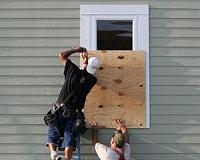| . |  |
. |
Kitty Hawk, North Carolina (AFP) Sept 2, 2010 Hurricane Earl bore down on a vast stretch of the US East Coast on Thursday, as tens of thousands of people fled North Carolina's barrier islands to avoid dangerous winds and surf. The strongest Atlantic storm of 2010, Earl was expected to remain offshore but still skirt much of the eastern seaboard beginning late Thursday. It is forecast to hit Canada's Nova Scotia by early Saturday. The US National Hurricane Center downgraded Earl to a category three hurricane but maintained its forecasted course set to bring destructive winds and heavy rains to North Carolina's coast before moving north. In its 0000 GMT advisory the NHC said the storm's sustained winds had dipped to near 110 miles (165 kilometers) per hour, but warned it was still a major hurricane expected to pass some 70 miles off North Carolina's Outer Banks, wreaking end-of-summer havoc for the Labor Day holiday weekend that draws millions to East Coast beaches. With the Miami-based center predicting hurricane strength winds as far as 70 miles (110 kilometers) from the eye, coastal North Carolina residents were battening down and tourists were scattering inland. "It's a serious storm, and we need to treat it like a serious storm," North Carolina Governor Beverly Perdue said Thursday. US officials ordered a mandatory evacuation for 30,000 residents and visitors of North Carolina's Hatteras Island. "This is a day of action," warned Craig Fugate, chief of the Federal Emergency Management Agency (FEMA). "People need to be rapidly completing their preparedness in the Carolina's Outer Banks, and for other folks along the East Coast they really need to focus today on what they are going to do when the storm gets there." FEMA said 400,000 liters of water and 300,000 meals were being allocated to a support center at a military base in North Carolina in preparation for the storm. For many tourists, Earl's arrival up-ended plans for a final few care-free days at the beach before the end of summer. And while some storm-hardened residents were ignoring evacuation orders, hardware store manager Chris Davidson said he planned to drive with his wife and two children about 100 miles inland, where his mother lives. "It seems like more people are taking it more seriously than in the past," Davidson told AFP. At 0000 GMT Earl was about 160 miles (260) kilometers south of Cape Hatteras in the Outer Banks -- a narrow band of North Carolina barrier islands. Despite a bright sunny day on the Carolina coast, the huge storm several hundred miles across was heading north at around 18 miles (30 kilometers) per hour. The NHC also issued a hurricane warning for coastal Massachusetts, including the popular retreat areas of Cape Cod, Nantucket and Martha's Vineyard, while the Canadian Hurricane Centre issued a hurricane watch for parts of Nova Scotia. Tropical storm warnings meanwhile were issued for points all along the US East Coast, as President Barack Obama signed a disaster declaration for North Carolina, ordering federal assistance to support response efforts. "This is a large system that impacts well away from the center, and time will be running out for people that had not got ready," Fugate warned. Davidson said vacationers were lamenting the premature end of their summer, while local business owners bemoaned lost revenue they had been counting on. "It'll definitely hurt the local economy. This was a big weekend for the hotels, restaurants and other businesses -- although for us, it could give us additional business once the storm is over, depending on how bad it is," he said. Earl was bringing an unwelcome end to what had been a banner year for coastal North Carolina. "A lot of businesses were depending on this weekend to finish the season strong," Davidson said. Meanwhile, forecasters were also closely tracking the path of Tropical Storm Fiona about 425 miles (680 kilometers) south of Bermuda, with wind speeds of up to 50 miles (85 kilometers) per hour. It is expected to rake over the island chain beginning late Friday. Gaston, the fourth tropical storm to form in the Atlantic over the past two weeks, weakened Thursday to a tropical depression, the NHC said, much to the relief of aid officials worried it would plow directly over Haiti, still recovering from January's massive earthquake. Also on Thursday, a pilotless NASA aircraft, a drone named Global Hawk, completed an overflight of Hurricane Earl, in a scientific first to gather data about the potentially deadly storm.
Share This Article With Planet Earth
Related Links Bringing Order To A World Of Disasters When the Earth Quakes A world of storm and tempest
 Evacuations start as US braces for Hurricane Earl
Evacuations start as US braces for Hurricane EarlRaleigh, North Carolina (AFP) Sept 1, 2010 Thousands of people evacuated North Carolina's barrier islands on Wednesday as a strengthened Hurricane Earl threatened to pound large areas of the US east coast with heavy winds and rough seas. The strongest Atlantic storm of 2010 was on a path to lash the North Carolina coast and then move north, wreaking havoc on the end-of-summer, US Labor Day holiday weekend that usually draws millions ... read more |
|
| The content herein, unless otherwise known to be public domain, are Copyright 1995-2010 - SpaceDaily. AFP and UPI Wire Stories are copyright Agence France-Presse and United Press International. ESA Portal Reports are copyright European Space Agency. All NASA sourced material is public domain. Additional copyrights may apply in whole or part to other bona fide parties. Advertising does not imply endorsement,agreement or approval of any opinions, statements or information provided by SpaceDaily on any Web page published or hosted by SpaceDaily. Privacy Statement |